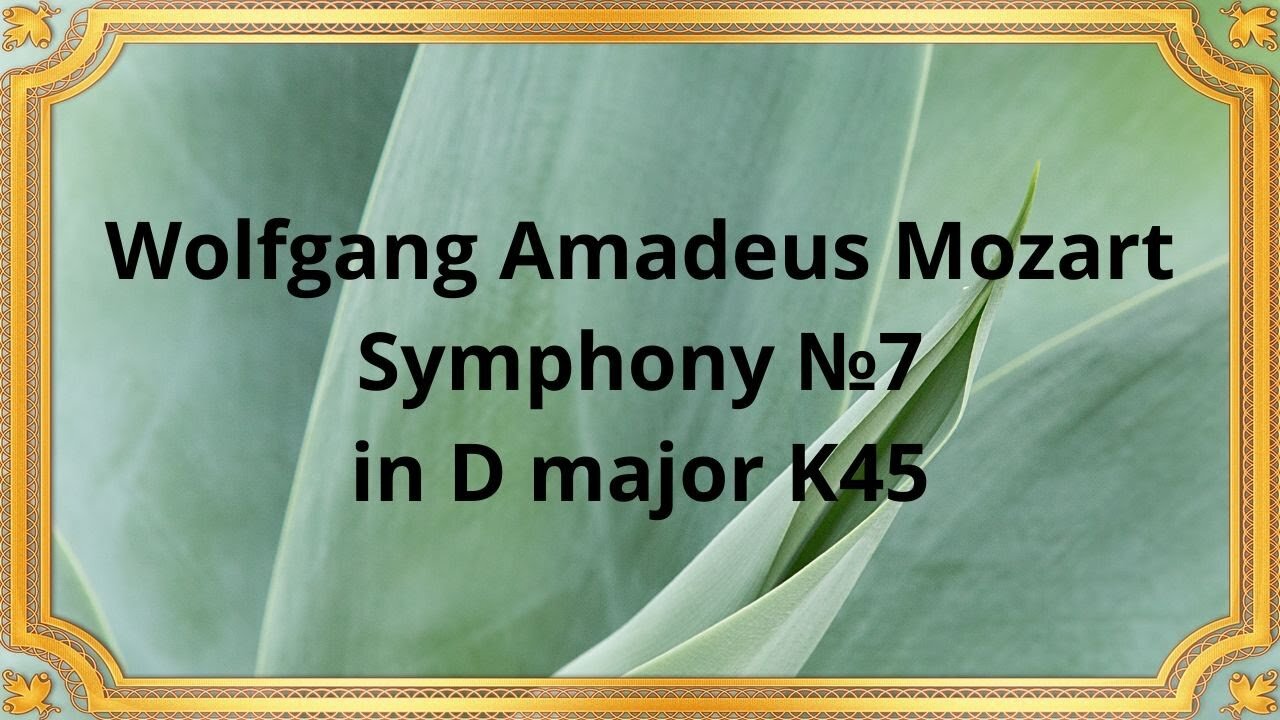Premium Only Content

Wolfgang Amadeus Mozart Symphony №7 in D major K45
#Mozart#Chamber_music#Classical_music#Symphony#Musical_composition
Wolfgang Amadeus Mozart was a prolific composer, and his Symphony No. 7 in D major K45 is one of his earliest works. Despite its relatively short length, this symphony displays the composer's prodigious talent and foreshadows the greatness that would come later in his career. In this article, we'll take a closer look at Mozart's Symphony No. 7 in D major K45 and why it remains a timeless masterpiece of classical music.
Mozart's Symphony No. 7 in D major K45: An Overview
Mozart composed Symphony No. 7 in D major K45 when he was just eight years old. The symphony is a three-movement work, with an opening Allegro followed by a central Andante and a closing Allegro. The first movement features a bright and energetic melody that is characteristic of Mozart's early works. The second movement is more introspective, with a gentle and lyrical theme that showcases the composer's sensitivity and emotional depth. The final movement is a joyful and lively piece that features a playful main theme and rich harmonies.
Symphony No. 7 in D major K45 is a significant work in Mozart's early repertoire. It displays the composer's precocious musical talent and serves as a testament to his ability to create engaging melodies and harmonies at a young age. Moreover, the symphony shows Mozart's early experiments with form and orchestration, which would later become hallmark features of his style.
The symphony's importance also stems from its influence on later composers. Mozart's innovative use of harmony and melody in this piece would inspire generations of composers to come, and his experiments with structure would pave the way for the development of classical music in the centuries that followed.
Symphony No. 7 in D major K45 is a must-listen for anyone who appreciates classical music. Its charming melodies, rich harmonies, and dynamic contrasts make it an enchanting work to listen to. Additionally, it is a great example of Mozart's early musical language and the roots of his later style.
Listening to Symphony No. 7 in D major K45 is also an opportunity to appreciate Mozart's remarkable talent and the exceptional achievements of classical music in the 18th century. The symphony's lively rhythms, expressive melodies, and imaginative orchestration provide a fascinating glimpse into the mind of one of the greatest composers of all time.
Conclusion
Mozart's Symphony No. 7 in D major K45 is a timeless masterpiece of classical music. Its engaging melodies, sophisticated harmonies, and impeccable orchestration make it a significant piece in the classical music tradition. Whether you are a seasoned classical music fan or a newcomer to the genre, Symphony No. 7 in D major K45 is a must-listen and a valuable addition to any music collection.
-
 16:45
16:45
Classical music_Music Inspiration
6 days agoSamuel Barber String Quartet, Op. II
512 -
 10:32
10:32
Nikko Ortiz
12 hours agoFunniest Fails Of The Month
14.7K3 -
 2:04:11
2:04:11
Side Scrollers Podcast
16 hours agoCracker Barrel CANCELS Rebrand + OG YouTuber Has Brain Tumor + More | Side Scrollers IN STUDIO
23.9K4 -
 19:26
19:26
GritsGG
8 hours agoChat Picked My Hair Color! All Pink Loadout & Operator Challenge!
2.24K3 -
 1:27:34
1:27:34
TruthStream with Joe and Scott
3 days agoArchitect Richard Gage: 911 truths and more #482
7.61K3 -
 3:47:17
3:47:17
The Pascal Show
16 hours ago $1.05 earnedBREAKING! Mass Shooting At Annunciation Church In Minneapolis Multiple Shot
18K7 -
 LIVE
LIVE
Lofi Girl
2 years agoSynthwave Radio 🌌 - beats to chill/game to
239 watching -
 2:02:49
2:02:49
Inverted World Live
7 hours agoAnnunciation Catholic School Shooting and Spiritual Warfare w/ AK Kamara | Ep. 99
194K23 -
 10:10
10:10
Robbi On The Record
3 days agoHollywood’s Hidden Messages: Predictive Programming & What’s Next
21.6K31 -
 4:43:34
4:43:34
Drew Hernandez
12 hours agoLGBTQ TERRORIST EXECUTES CATHOLIC KIDS IN MINNEAPOLIS
21.8K18